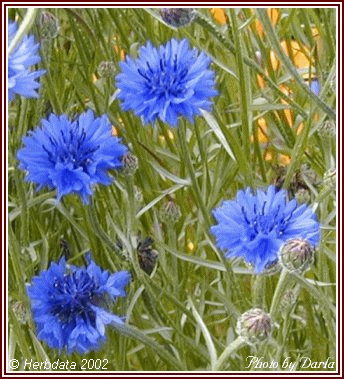
 Centaurea Cyanus. Linn
Centaurea Cyanus. Linn
Common
Names: .Cornflower
Bluebottle. Bluebow. Hurtsickle.
Family: N.O. Compositae
Part Used
Medicinally.
Flowers.
Centaurea Cyanus, the Cornflower, with
its star-like blossoms of brilliant blue, is one of our most striking
wild-flowers, though it is always looked on as an unwelcome weed by the
farmer, for not only does it by its presence withdraw nourishment from the
ground that is needed for the corn, 'but its tough stems in former days of
hand-reaping were wont to blunt the reaper's sickle, earning it the name of
'Hurt Sickle':
The Latin name, Cyanus, was given the Cornflower after a youthful devotee of the goddess Flora (Cyanus), whose favourite flower it was, and the name of the genus is derived from the Centaur, Chiron, who taught mankind the healing virtue of herbs.
Description. The stems are 1 to 3 feet high, tough and wiry, slender, furrowed and branched, somewhat angular and covered with a loose cottony down. The leaves, very narrow and long, are arranged alternately on the stem, and like the stem are covered more or less with white cobwebby down that gives the whole plant a somewhat dull and grey appearance. The lower leaves are much broader and often have a roughly-toothed outline. The flowers grow solitary, and of necessity upon long stalks to raise them among the corn.
Part Used Medicinally. The flowers are the part used in modern herbal medicine and are considered to have tonic, stimulant and emmenagogue properties, with action similar to that of Blessed Thistle.
A water distilled from Cornflower petals was formerly in repute as a remedy for weak eyes. The famous French eyewash, 'Eau de Casselunettes,' used to be made from them. Culpepper tells us that the powder or dried leaves of the Bluebottle is given with good success to those that are bruised by a fall or have broken a vein inwardly. He also informs us that, with Plantain, Horsetail, or Comfrey,
The expressed juice of the petals makes a good blue ink; if expressed and mixed with alum-water, it may be used in water-colour drawing. It dyes linen a beautiful blue, but the colour is not permanent
The dried petals are used by perfumers for giving colour to pot-pourri.
Abstracted and abridged from :
A Modern Herbal by Mrs M. Grieve F.R.H.S. 1931.
![]()